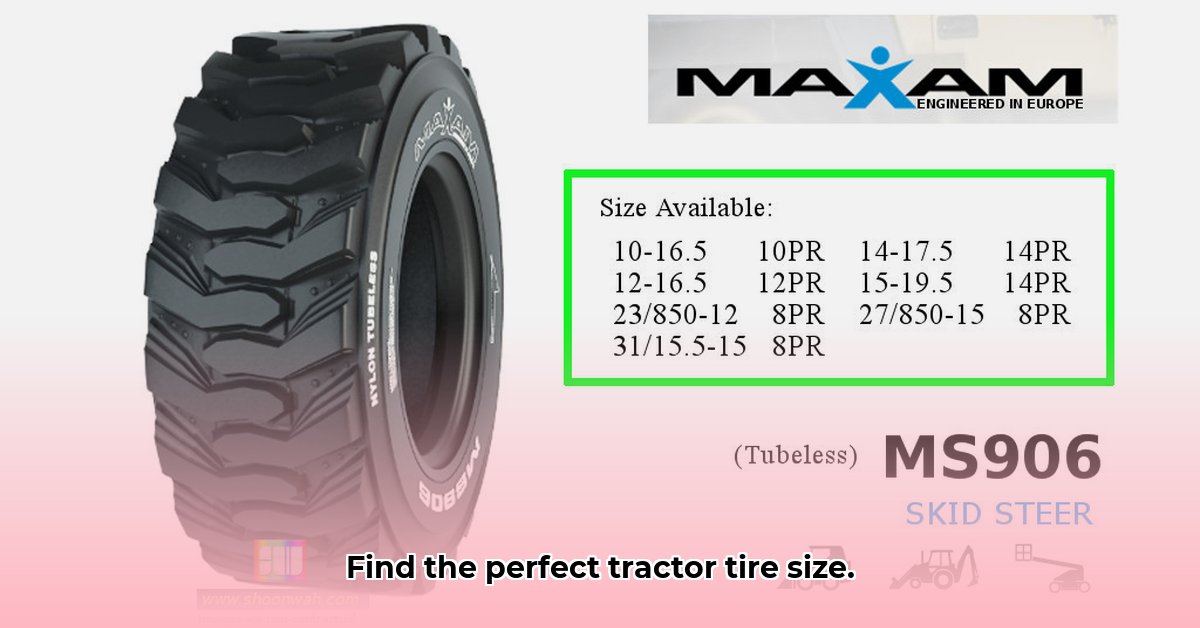
Choosing the right 15-19.5 tractor tires is crucial for safety, efficiency, and minimizing downtime. This comprehensive guide simplifies the selection process, helping you navigate the technical specifications and make informed decisions. We'll cover tire specifications, a step-by-step selection process, maintenance tips, and considerations for comparing brands. For larger tractors, consider exploring options like 28-inch tractor tires.
Understanding 15-19.5 Tractor Tire Specifications
Before selecting tires, understanding key specifications is paramount. These specifications directly impact performance and longevity.
Ply Rating (PR): Strength and Load Capacity
The ply rating (PR) indicates the tire's strength and load-carrying capacity. A higher PR number signifies a stronger, more durable tire suitable for heavier loads and challenging terrains. For example, a 6PR tire is suitable for lighter tasks, while a 16PR tire is designed for heavy-duty applications. Choosing the correct PR is vital for preventing tire failure – a costly and potentially dangerous issue. What PR rating is appropriate for your typical workload?
Tread Pattern (R-4): Traction and Self-Cleaning
The R-4 tread pattern is common for 15-19.5 tractor tires. Its deep lugs provide excellent traction in diverse terrains, from muddy fields to rocky surfaces. The deep tread also aids self-cleaning, preventing mud and debris buildup that reduces traction. While the R-4 is the standard, variations exist that enhance performance in specific conditions (e.g., wet clay). Does your terrain require a specific R-4 variation?
Load Capacity: The Maximum Safe Weight
Load capacity represents the maximum weight a tire can safely support. Exceeding this limit can cause tire failure. Always consult your tractor's owner's manual to determine the required load capacity for each axle. Accurate load assessment is vital to prevent potential damage and safety hazards. Have you accurately determined the load capacity needed for your tractor and its applications?
Tire Size (15-19.5): Rim Diameter and Width
The "15-19.5" designation indicates tire dimensions. "15" refers to the rim diameter (in inches), while "19.5" represents the nominal tire width (in inches). Ensure the chosen tire size matches your tractor's wheel specifications. Incorrect sizing can lead to fitment problems and potentially damage your equipment. Is the 15-19.5 size compatible with your tractor wheels?
Step-by-Step Guide to Selecting the Right Tire
This structured approach ensures you choose the tire best suited for your needs.
Step 1: Assess Your Workload: What are your tractor's primary tasks? Heavy hauling, light tillage, or a combination of activities? This determines the load and stress your tires will endure.
Step 2: Calculate the Load: Determine the total weight your tractor will carry, including its own weight, implements, and payload. This calculation is crucial for selecting the appropriate ply rating and preventing overloading.
Step 3: Select the Appropriate Ply Rating (PR): Based on your load calculation, choose a tire with a PR exceeding your expected weight. Higher PR tires offer increased load capacity and durability, but they tend to be more expensive. The tradeoff will depend heavily on the demands of your use-case.
Step 4: Consider the Terrain: The operating environment significantly influences tire choice. Rough terrain necessitates durable tires with aggressive tread patterns (higher PR) to withstand impacts. Smoother surfaces allow for tires with slightly lower PR ratings, offering cost savings without sacrificing performance.
Step 5: Research Reputable Manufacturers: Galaxy, Maxam, and Duramax are examples of reputable manufacturers. Compare their offerings, focusing on specifications, warranties, and pricing. While direct comparisons are challenging due to data availability, understanding individual manufacturer claims offers valuable insights.
Step 6: Check Warranty and Availability: Verify warranty terms and ensure local availability of the chosen tires for minimizing downtime if repairs or replacements are ever needed.
Tire Maintenance: Extending Lifespan and Ensuring Safety
Proper maintenance is essential for maximizing tire life and mitigating risks.
- Regular Inspections: Inspect tires regularly for cuts, bulges, and excessive wear. Early detection can prevent major problems.
- Proper Inflation: Maintain the recommended inflation pressure (found on the tire sidewall). Underinflation causes excessive wear and overheating, while overinflation weakens the tire's structure.
- Load Management: Avoid overloading tires, ensuring even weight distribution.
- Addressing Potential Risks: Regular inspection, appropriate load management, and adherence to recommended inflation pressures minimize the risk of sudden tire failure.
Conclusion: Informed Choices for Optimal Performance
Choosing the right 15-19.5 tractor tire involves careful consideration of various factors. By following this guide and understanding the key specifications, you can make informed decisions prioritizing safety, efficiency, and equipment longevity. If you're unsure, consult with a tire professional for personalized recommendations.